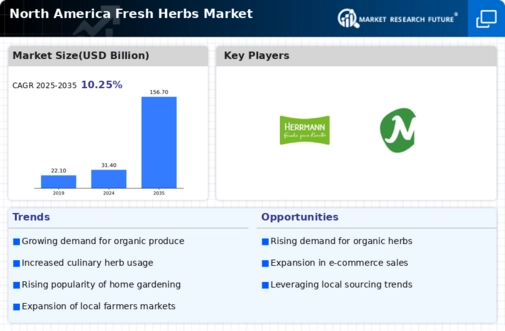Top Industry Leaders in the North America Fresh Herbs Market

Strategies Adopted by North America Fresh Herbs Key Players
The North America fresh herbs market is a dynamic sector shaped by consumer preferences for healthier food options and an increasing demand for culinary diversity. Examining its competitive landscape requires an exploration of key players, strategies, market share factors, new entrants, industry news, investment trends, the overall competitive scenario, and notable developments, especially in 2023.
List of Key Players
- Herrmann Kraeuter
- Van Vugt Herbs
- Vitacress Herbs
- Coolibah Herbs
- Hermitage Produce
- Agromediterranea
- Holla-Fresh Pty Ltd
- North Shore Greenhouses
- Australian Fresh Leaf Herbs
Strategies adopted by major players in the North America fresh herbs market are centered around sustainable farming practices, diversification of product portfolios, and innovative packaging solutions. Shenandoah Growers, for instance, emphasizes its commitment to organic and locally grown herbs while also expanding its range to include exotic and culinary herbs. Diversification strategies include the cultivation of rare herbs to cater to niche markets.
Factors for Market Share Analysis
Market share analysis in the North America fresh herbs market is influenced by factors such as product quality, distribution efficiency, adherence to organic and sustainable practices, and responsiveness to changing consumer preferences. Companies that can consistently deliver high-quality fresh herbs and adapt to evolving culinary trends are well-positioned to secure and expand their market share.
New and Emerging Companies
The market has witnessed the emergence of new companies focusing on niche segments or introducing innovative growing techniques. Start-ups like Urban Cultivator are gaining attention by offering in-home herb cultivation systems, appealing to consumers seeking convenience and freshness. These new entrants contribute to market dynamism by bringing novel solutions and technologies to herb production and distribution.
Industry News and Current Company Updates
Recent industry news has highlighted the increasing popularity of indoor herb gardening among consumers. This trend is prompting companies to explore partnerships with technology providers for smart herb cultivation solutions. Additionally, there is a growing emphasis on sustainable packaging solutions, with companies like Pacific Botanicals actively adopting eco-friendly packaging to meet consumer demands for environmentally conscious choices.
Investment Trends
Investments in the North America fresh herbs market are focused on enhancing production efficiency, sustainable farming practices, and technology adoption. Companies are investing in advanced greenhouse technologies, automation in cultivation, and precision farming techniques to optimize yields and reduce environmental impact. The trend also includes investments in research and development for new herb varieties that align with changing consumer preferences.
Overall Competitive Scenario
The overall competitive scenario in the North America fresh herbs market is marked by intense competition among established players and the potential disruption posed by innovative start-ups. As consumers increasingly prioritize health and freshness in their diets, companies are striving to differentiate themselves through sustainable practices, product innovation, and strategic partnerships with retailers and foodservice providers.
Recent Development
The North America fresh herbs market experienced notable developments. One significant trend was the increased adoption of vertical farming techniques by major players. This approach allows for year-round herb cultivation in controlled environments, addressing seasonal challenges and ensuring a consistent supply of fresh herbs. Companies investing in vertical farming technologies gained a competitive advantage by offering a reliable and steady stream of products to meet market demand.
Furthermore, there was a surge in the popularity of rare and exotic herbs. Consumers, driven by a desire for unique culinary experiences, sought out herbs like Thai basil, lemon balm, and epazote. In response, market leaders diversified their product offerings to include a broader range of herbs, leveraging consumer interest in diverse flavors and international cuisines.
Another notable development was the increased collaboration between herb producers and retailers to promote localized and community-supported agriculture. Companies like Green Valley Greenhouse partnered with grocery chains to create herb-centric promotional campaigns, emphasizing the freshness and local origin of their products. This approach not only strengthened ties with retailers but also resonated with consumers looking for locally sourced and sustainable options.
In terms of sustainability, companies in 2023 took substantial strides towards reducing the environmental impact of herb cultivation. Initiatives included the implementation of eco-friendly packaging, water-saving irrigation systems, and renewable energy adoption in greenhouses. Such efforts aligned with growing consumer expectations for responsible and environmentally conscious business practices.










